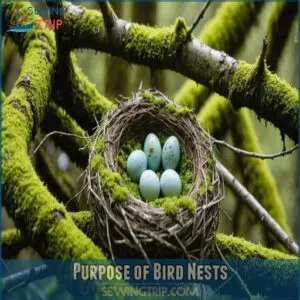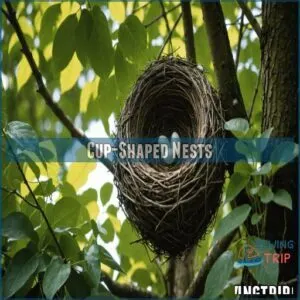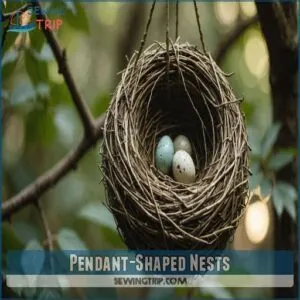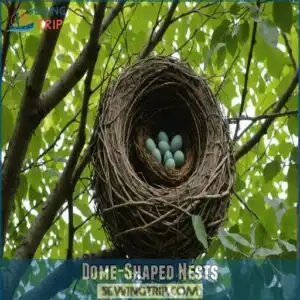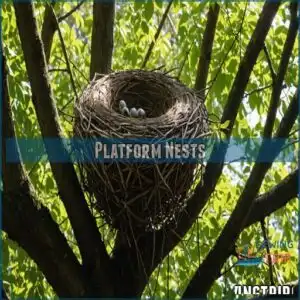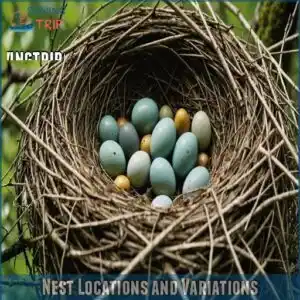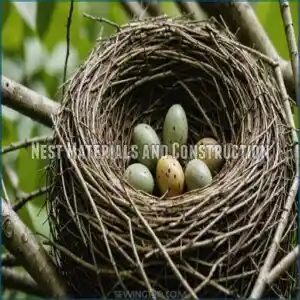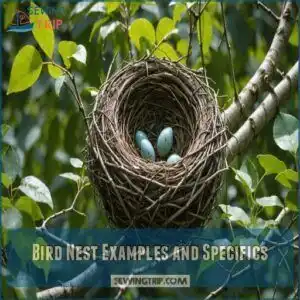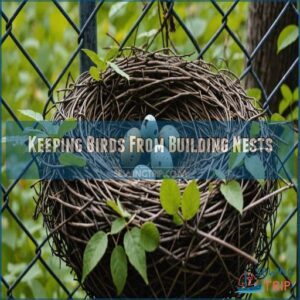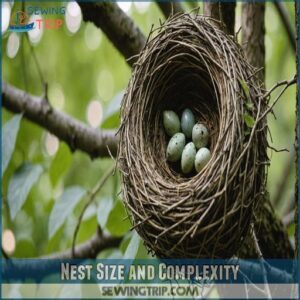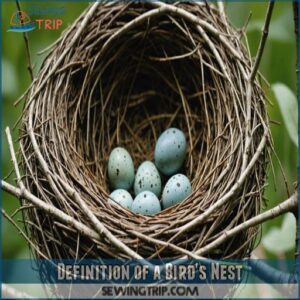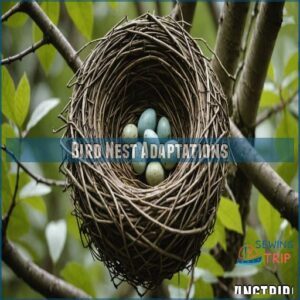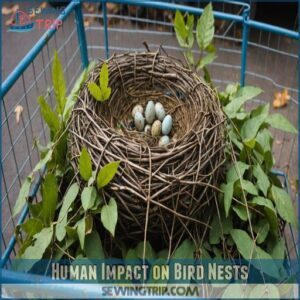This site is supported by our readers. We may earn a commission, at no cost to you, if you purchase through links.
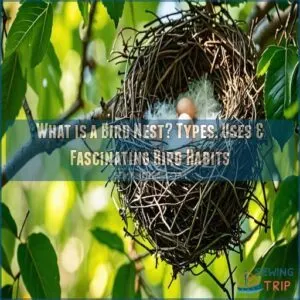
It’s like the ultimate DIY project they ace, using twigs, grass, and even urban treasures like string or plastic.
These nests serve as safe havens for eggs and chicks, keeping them snug and secure from predators and harsh weather.
Birds are nature’s architects; each species crafts its nest in unique ways—think cup-shaped, dome-like, or dangling pendants!
Intrigued by these feathery engineers? Just wait until you discover their fascinating building techniques and materials.
Curious about those? You’ll find that’s just the tip of the iceberg!
Table Of Contents
- Key Takeaways
- Purpose of Bird Nests
- Types of Bird Nests
- Nest Locations and Variations
- Nest Materials and Construction
- Bird Nest Examples and Specifics
- Keeping Birds From Building Nests
- Nest Size and Complexity
- Definition of a Bird’s Nest
- Bird Nest Adaptations
- Human Impact on Bird Nests
- Frequently Asked Questions (FAQs)
- Conclusion
Key Takeaways
- You’ll see that bird nests are vital for egg incubation and chick rearing, providing safety from predators and harsh weather.
- They display incredible architectural variety, with styles like cup-shaped, dome, and pendant nests, each adapted to their environment.
- Birds cleverly use both natural and artificial materials, showing adaptability in nest building and construction techniques.
- Human impact, through habitat destruction and urban development, challenges birds, but conservation efforts strive to protect their nesting grounds.
Purpose of Bird Nests
You’ll find that bird nests aren’t just cozy homes; they’re essential for successful reproduction.
A bird’s nest provides a safe, climate-controlled environment for incubating eggs and raising vulnerable chicks, protecting them from harsh weather and hungry predators.
Secure Environment for Egg Incubation
Imagine a snug bird nest, like nature’s version of a cozy incubator.
It’s all about the egg protection strategies.
Birds expertly select nesting materials to guarantee proper temperature regulation and insulation, creating the perfect spot for safe egg incubation.
By controlling the incubation duration, they set the stage for successful hatching, highlighting their parental care dynamics.
Safe Environment for Chick Rearing
When birds create a nest, they aim for safety and nurturing for chick rearing. Here’s why it’s important:
- Parental care involves selecting the right spot free from nest predators.
- Many birds build their nests using materials found in their natural habitats, which can be replicated with bird-friendly products from bird nest design.
- Cup nests snugly cradle young chicks.
- Nest materials include twigs and leaves for comfort.
- Bird habitats influence nest design for best chick development and protection.
Temperature and Humidity Maintenance
A bird’s nest acts like a natural thermostat, balancing egg temperature with clever nest insulation.
Did you know humidity control is key to successful bird incubation?
Nests crafted from specific nesting materials cleverly maintain the right climate.
So, as nature’s little architects, birds create homes that adapt to the climate, ensuring their offspring have the best start.
Protection From Predators and Elements
Bird nests ingeniously offer protection from predators and elements.
By blending seamlessly into their surroundings, nests use camouflage to stay hidden.
Strategic nest placement shields them from harsh weather and keen-eyed predators.
It’s all about staying one step ahead—like a well-planned game of hide-and-seek.
This clever nest defense guarantees a safer home for little ones, balancing nature’s demands with practical nesting habits.
Types of Bird Nests
You’ll encounter an impressive variety of bird nests, each uniquely adapted to protect and nurture their inhabitants.
Whether it’s a hummingbird’s tiny cup or an eagle’s massive platform, these homes reflect the diverse strategies birds use to survive and thrive in their environments.
Cup-Shaped Nests
Cup-shaped nests are intriguing structures built by many bird species.
These nests are made using materials like twigs and grass, perfectly shaped to cradle the eggs safely.
You’ll find them in trees and bushes, often blending perfectly with their surroundings.
- Location: Trees and shrubs
- Size: Depends on bird species
- Materials: Twigs, leaves
- Function: Egg protection
Pendant-Shaped Nests
Hanging from branches, you’ll find pendant-shaped nests, a marvel of bird architecture!
These aren’t your average nests; think woven pouches, expertly crafted by species like orioles and weaver birds.
Nest construction involves incredible skill, ensuring nest stability.
These hanging nests offer protection from predators and the elements, showcasing amazing bird nesting habits.
The nesting locations are often high up, providing a safe haven.
You’ll find these unique bird nests in diverse habitats.
Dome-Shaped Nests
Imagine you’re a bird trying to stay cozy and safe.
Dome-shaped nests, with their roundish design, offer excellent insulation, keeping eggs warm despite harsh climates.
These bird nests cleverly hide from predators, utilizing various materials to blend into their surroundings.
Perfect for bird species requiring secure bird nesting sites, these nests showcase nature’s ingenious architecture at its best.
Platform Nests
Switching from enclosed dome-shaped nests to expansive platform nests might feel like swapping a snug apartment for a sprawling open deck.
Built by large birds like eagles, these nests are sturdy, flat structures elevated high in trees or on cliffs.
Platform nest materials range from sticks to softer substances, ensuring safety during the bird breeding season, while keeping pesky predators at bay.
Cavity Nests
Cavity nests are nature’s hidden treasures, snugly tucked inside trees or man-made boxes.
Woodpeckers, nuthatches, and chickadees expertly carve these secret chambers.
They offer a stronghold against cavity nest predators, yet they aren’t immune to competition or cavity nest parasites.
Keep an eye on maintenance because these cozy niches require upkeep to provide a safe space for bird eggs and young.
Nest Locations and Variations
You’ll find that birds have some surprising tastes in real estate, choosing anything from towering trees to cozy underground burrows.
Whether they’re nesting on towering cliffs or tucked inside your backyard mailbox, their nesting spots are as varied as a pack of Skittles.
Tree and Bush Nests
In the vibrant world of bird nests, trees and bushes are prime real estate.
You’ll find a variety of nests tucked safely among branches, ranging from cup-shaped to dome nests.
Here are three insights on tree and bush nests:
- Nest Construction: Materials vary widely.
- Nest Camouflage: Blending in is key.
- Nest Defense: Strategic placement wards off threats.
Ground Nests
Imagine strolling through a forest, eyes peeled for bush nests.
Now glance downward and consider ground nests.
These treasures lie in plain sight, expertly camouflaged against sneaky predators.
Built by shorebirds and others, they use varied nesting materials to keep eggs cozy during the incubation period.
Embrace birdwatching and discover unique bird species’ secrets hidden at ground nest locations.
Cliff and Ledge Nests
Many birds cleverly choose cliffside ledge nests for their homes. These locations offer some advantages, but also present unique challenges. What’re some of these?
- Cliffside nesting locations provide natural protection from ground predators.
- Ledge nesting adaptations, like strong claws, help birds grip the cliff face.
- Nest security challenges include harsh weather and accessibility for predators.
- Cliff nesting birds often choose sheltered ledges for better protection.
- Identifying ledge nesting species requires careful observation and bird identification skills.
Underground Nests
You might picture birds as master cliff-hangers, but they also surprise us with underground nests.
Burrowing Owls and Bank Swallows use these cozy burrows to avoid predators and harsh weather.
You can find products related to burrowing owl nests online, showcasing the ingenuity of these birds.
These nests support bird breeding and development, proving clever Nest Design plays a role in avian evolution and Conservation Efforts.
| Species | Habitat |
|---|---|
| Burrowing Owls | Grasslands, deserts |
| Bank Swallows | Riverbanks, cliffs |
| Belted Kingfishers | Riverbanks |
| Atlantic Puffins | Coastal areas |
Artificial Structure Nests
Discover the marvels of artificial structure nests, where birds cleverly adapt to urban landscapes.
Birdhouse design and strategic nest box placement in cities provide safe havens.
Birds use artificial materials creatively, turning human-made spaces into cozy nests.
This adaptability highlights the importance of urban bird nesting in bird conservation, offering them protection in bustling environments like bird sanctuaries and reserves.
Nest Materials and Construction
When it comes to bird architecture, you’ll find nests are crafted from an eclectic mix of materials, ranging from twigs and leaves to the occasional shoelace snagged from a clothesline.
Birds are master constructors, using these elements not just for strength and stability, but also to create cozy, safe havens for their eggs and chicks.
Natural Materials Used
From hidden cliff nooks to cozy crevices, birds fashion nests using nature’s bounty.
Twigs, moss, feathers, and bark become sustainable nests for protection and comfort.
As material availability shifts, birds adapt, showcasing remarkable nest material evolution.
Picture a sturdy pendant-shaped nest or a soft scrape nest, each reflecting its environment’s material impact, making each avian home unique.
Artificial Materials Used
Picture a bird nest adorned with shimmering bits of plastic — it’s like modern art with a purpose.
Some birds even use threads from discarded clothing, like those made from a 65% cotton to 35% polyester blend, use poly cotton for quilting to create their nests.
Birds, perhaps learning recycling better than humans, often incorporate artificial materials into their nests.
While this might reflect human influence, it’s also a safety hazard.
These nest safety hazards demand our awareness and bird conservation efforts to protect our feathered friends’ homes.
Nest Lining Materials
Feeling at home matters, even for birds!
Nest lining materials play a key role in cushioning and insulating.
Birds cleverly choose soft items to provide comfort and safety.
Check out these essentials:
- Feathers and Fur: For that cozy warmth.
- Moss and Grass: Adds softness and blends with the environment.
- Spider Silk: Amazingly robust and flexible.
Nest Building Techniques
Ingenious nest construction varies wildly! You’ll find birds weaving intricate cup nests from twigs and grasses, while others build sturdy platforms of sticks. Some cleverly use mud or spider silk for added strength.
Nest placement, too, is key—consider the protection offered by tree hollows or the camouflage of dense foliage. These choices impact baby bird survival, showcasing the amazing adaptability of avian architects!
Ornithology reveals fascinating nest evolution, reflecting bird growth and migration patterns.
Bird Nest Examples and Specifics
You’ll find that bird nests come in a variety of shapes and locations, each offering a unique twist on avian architecture.
From the cozy cup nests of robins to the impressive ground scrapes of killdeer, these homes reveal fascinating adaptations to their habitats.
Cup Nests
After learning about various nest materials, you’ll find cup nests fascinating.
These common structures, crafted by birds like robins and sparrows, are masterpieces of weaving.
Using twigs, grass, and mud, they showcase a diverse building process.
Nest placement in trees helps evade predators.
This style’s evolution highlights versatility and resilience, with cup nest variations for different environments.
Pendant Nests
While cup nests are cozy, think of pendant nests like bird versions of stylish hanging lamps.
Birds such as orioles and weavers create these marvels using fibers and grasses.
Hanging from branches, they offer some neat tricks against predators.
But constructing these swaying structures challenges birds, requiring precision and a knack for tying knots.
Nature’s architects truly shine here!
Scrape or Ground Nests
Picture a bird’s version of roughing it with ground nests.
These nests, mere shallow scrapes in dirt or gravel, rely on clever egg camouflage to dodge predator threats.
Just as upcycling [fabric scrap ideas](https://sewingtrip.com/sewing-projects-using-scraps/#:~:text=Sewing with scraps is budget-friendly and benefits the) can breathe new life into old materials, a bird’s instincts to craft a simple yet effective ground nest is a remarkable display of resourcefulness.
During nesting season, your role as a responsible observer is vital—offering ground nest care and protecting them from unwelcome disturbances.
It’s a delicate balance of wilderness charm and attentive guardianship.
Keeping Birds From Building Nests
If you’re trying to keep birds from nesting in unwanted places around your home, a few effective strategies can help.
Removing food sources, tidying up hiding spots, and installing barriers can make your area less inviting to our feathered friends, leaving them chirping for better spots elsewhere.
Removing Food Sources
Birds are drawn to easy snacks, so managing food sources is key.
Keep bird feeders tidy and free from spills.
Opt for closed containers to store birdseed.
Compost food waste properly to avoid unwanted scents.
Regularly maintain garbage cans with secure lids.
Thoughtful landscaping can minimize food attraction—this way, birds won’t eye your yard as their next dining spot.
Removing Hiding Places
Next, tackle those tempting hiding spots!
A good yard cleanup is key.
Remove dense vegetation and brush; birds love these for nesting.
Think of it as decluttering, but for feathered friends.
Shelter removal means less places for them to build nests.
Reduce debris; a tidy space is less appealing to birds.
Remember, a clean yard is a bird-nest-free yard!
Setting Up Barriers
Cleaning up hidden spots is half the battle; setting up barriers finishes the job.
Picture these strategies:
- Roosting spikes: They’re like "do not disturb" signs for unwanted bird guests.
- Predator models: These tricks can scare birds into seeking safer ground.
- Protective covers: They act like umbrellas over vulnerable spots.
Mix these with bird repellent and flashing objects for a welcoming, yet nest-free zone!
Using Non-Toxic Repellents
Imagine this: you’re lounging in your backyard, when suddenly, little feathered architects eye your space for their next Airbnb.
To keep things cozy for yourself, try non-toxic repellents.
They’re effective and safe, like mint sprays or shiny foil.
Consider these options:
| Repellent Type | Effectiveness | Safety |
|---|---|---|
| Mint Spray | High | Safe |
| Shiny Foil | Medium | Very Safe |
| Citrus Oils | Low | Safe |
These DIY solutions respect bird behavior and offer alternative solutions.
Nest Size and Complexity
When you explore the realm of bird nests, you’ll find a surprising range from tiny, delicate constructions to massive, fortress-like structures.
Whether it’s a hummingbird’s cup-sized nest or a bald eagle’s multi-story masterpiece, each nest showcases the bird’s ingenuity and resourcefulness.
Large Bird Nests
Imagine stumbling upon a bald eagle’s nest, a true marvel of engineering!
These large bird nests can be up to 10 feet across and weigh over 4,400 pounds.
Crafted with various nest materials including sticks and lined with softer materials for comfort, these structures showcase nature’s nest evolution, demonstrating impressive nest building and maintenance techniques in diverse nest locations.
Small Bird Nests
Regarding small bird nests, think tiny masterpieces woven with care.
Hummingbirds take the prize, crafting their cups from delicate materials like plants and spider webs. When sewing on delicate materials, it’s essential to choose soft lightweight stabilizers to prevent puckering while stitching, as outlined in techniques for embroider letters on shirt.
Just as kids can create their own charming DIY projects, such as fun sewing projects for kids, these birds demonstrate remarkable skill in using available materials to build intricate nests.
These nests, not much bigger than a golf ball, cleverly conceal nestled chicks from threats.
You’ll be amazed by their skill and the use of available nest materials in such limited space.
Pendant Oriole Nests
Ever marveled at the intricate weave of a pendant oriole nest?
These masterpieces hang gracefully from branches, showcasing nest construction that’s both artistic and functional.
You can even purchase a Pendant Oriole Nest Kit to learn about the intricacies of their nest building.
Using long grasses and twine, orioles create cozy homes that dangle like natural chandeliers.
Their clever nest placement wards off predator threats, ensuring safety for their chicks.
It’s nature’s way of crafting security with style!
Scrape Nests
So, you’ve seen the intricate hanging nests of orioles. Now, let’s look at something simpler: scrape nests. These are basically shallow depressions, often in the ground. They’re surprisingly effective! Think of them as nature’s minimalist approach to nesting.
Ground nesting predators are a real threat, impacting nesting success rates. Scrape nest location is key for camouflage.
- Minimal effort, maximum impact.
- Scrape nest maintenance is low-key.
- Camouflage is essential for survival.
Underground Bird Nests
Scrapes on the surface work for some birds, but underground nests take the concept literally to a new depth.
With burrowing owl adaptations and bank swallow colonies exemplifying this style, it’s less about size and more about safety.
Nest cavity size varies, but the primary aim is predator avoidance.
Despite underground nest dangers, they cleverly use earth to protect vulnerable young.
Definition of a Bird’s Nest
As you’ve explored nest size and complexity, you might wonder what truly makes a bird nest tick.
A bird’s nest is much more than a cozy cradle for eggs and chicks.
It’s a marvel of nest evolution, shaped by the need for safety and comfort.
Just like a sewer uses high-quality vintage sewing threads, birds carefully select materials for their nests, often going to great lengths to find the perfect twigs and leaves.
Nests come in countless shapes and sizes, each designed for specific environments:
- Nest Location: From branches to ground level, location is key.
- Nest Materials: Twigs, leaves, and even recycled human items find their place.
- Nest Function: Beyond a bed, nests offer protection from predators and bad weather.
Isn’t it fascinating how such delicate structures hold so much importance?
Bird Nest Adaptations
In terms of adapting to their surroundings, birds are quite the innovators.
You’ll be amazed at how nests evolve to suit different climates and defend against predators, showing nature’s flair for clever design!
Climate Adaptations
Bird nests aren’t just homes; they’re masterpieces of climate adaptation.
By selecting the right Nesting Materials and Nest Placement, birds manage Thermal Regulation to keep their chicks cozy or cool, depending on the weather.
Think of Seasonal Adjustments and clever Nest Shapes as the birds’ way of beating the elements.
It’s like nature’s way of wearing a perfect outfit for every season!
Predator Defense Adaptations
Imagine you’re a tiny bird, building a nest.
You’re not just making a home; you’re setting up a fortress!
Just like a tailor carefully chooses a stitch for sewing, birds carefully select materials and designs for their nests to protect their young from predators.
Protecting your young from predators involves:
- Camouflage: Blending the nest with its surroundings.
- Nest Placement: Choosing high or hidden spots.
- Alarm Calls: Warning signals to alert others.
- Mobbing Behavior: Gang-up tactics to scare threats.
It’s natural survival at its best!
Human Impact on Bird Nests
When you think about the impact humans have on bird nests, it’s clear that habitat destruction and urban development are shaking things up for our feathered friends.
While conservation efforts aim to balance the scales, it can sometimes feel like a bird trying to build a nest during rush hour traffic.
Habitat Destruction
Over time, human actions greatly impact bird nests.
Deforestation removes nesting trees, while urban sprawl fragments habitats.
Climate change alters weather patterns, affecting nesting success.
Pollution contaminates nesting materials, harming birds.
Invasive species compete for resources and nesting sites.
These factors threaten bird populations; it’s a real-world problem impacting biodiversity.
We need to understand how these issues affect birds.
Conservation Efforts
Join conservation efforts and see positive change for bird nests.
You’re key to supporting these initiatives, which include:
- Nest box design: Create homes for cavity nesters.
- Habitat restoration: Plant trees and protect landscapes.
- Sustainable nesting: Encourage eco-friendly materials.
- Bird banding: Track species and populations.
- Citizen science: Join projects that monitor nest health.
Together, these efforts help protect avian safety.
Frequently Asked Questions (FAQs)
What is the best bird nest to buy?
Ironically, the best bird nest isn’t one you buy.
Instead, create a welcoming space with natural materials like twigs and leaves.
Birds love variety, so offer different spots—trees, ledges, or bushes—to attract them naturally.
Is it legal to possess a bird nest?
Possessing a bird nest is generally illegal in many places without a permit due to wildlife protection laws.
It’s important to check local regulations because rules vary, and some bird nests are protected to preserve species and ecosystems.
How many years has the Bird Nest been in operation?
Oh, you’ve stumbled upon a tricky one!
If you’re asking about Beijing’s Bird’s Nest Stadium, it opened in 2008, so it’s 16 years old now.
Confusing architecture for avian lodging is quite a nest misstep!
What type of parts and services does the Bird Nest provide?
You’ll find varying services depending on the specific "Bird Nest." Some offer repairs, parts for various bird species, and even nest building consultations. It’s best to check their specific offerings.
Why is a bird’s nest illegal?
Like taking a protected flower, possessing a bird’s nest can be illegal due to wildlife protection laws.
These laws help preserve bird populations by safeguarding their habitats.
Just enjoy watching nest building from a safe distance!
Why do people eat birds’ nests?
People eat birds’ nests, mainly swiftlet nests, because they’re highly valued in Chinese cuisine for their unique texture and potential health benefits.
These nests are believed to enhance immunity, improve skin, and support overall wellness.
What does a bird’s nest taste like?
Connoisseurs might describe the taste of bird’s nest as a culinary enigma.
It’s mildly sweet and has a gelatinous texture, a bit like a smooth jelly.
Often, it’s enjoyed more for its texture than its flavor.
What is a bird’s nest drink made of?
A bird’s nest drink is made from the edible saliva of swiftlets.
When softened in water, it forms a gelatinous texture.
You’re in for a treat, often sweetened and enjoyed for its unique texture and health benefits.
How do birds choose nesting locations?
Why do birds get prime real estate for their homes while we’re stuck in endless hunts?
Birds pick nesting spots based on safety, food availability, and climate.
They seek hidden, cozy places like trees or cliffs to shield offspring.
What are bird nesting habits in winter?
Birds’ winter nesting habits vary.
Some migrate to warmer locales, skipping nests, while others gather in flocks or roosts for warmth.
A few, like chickadees, use tree cavities or crowded shelters to endure cold spells.
Do all bird species build nests?
Think of it like this: not all birds are nest-builders!
Some species, like penguins, skip the nest altogether.
Others lay their eggs directly on the ground or in burrows.
It all depends on the species and their environment.
How do birds defend their nests?
Picture a tiny superhero defending its lair.
Birds defend nests by diving at threats, using alarm calls, or faking injury to lure predators away.
Some even form neighborhood watch groups, showing strength is in numbers!
Are any bird nests reused by birds?
Yes, some birds like owls and swallows frequently reuse nests, saving time and energy.
It’s like recycling with a feathery twist—nature’s way of saying why fix what’s not broken!
New tenants? Just add twig decor.
Conclusion
While we humans labor to build sturdy houses, birds, without architectural degrees, effortlessly craft nests to protect their young.
These natural wonders offer insights into survival and adaptability, presenting a variety of forms and functions.
From cup-shaped cradles high in trees to simple scrapes on the ground, each nest showcases the creativity ingrained in nature.
Curious about what’s a birdnest? It’s a clear demonstration of how life can thrive with ingenious solutions and resourcefulness.

